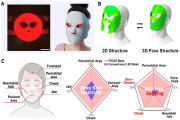With the continuous advancement of LED technology, LED displays are appearing in more diverse applications such as extended reality (xR) filmmaking displays, glasses-free 3D screens, all-in-one machines, cinema displays, rental screens, transparent displays, and flexible screens. These innovative applications have accelerated the integration of LED displays into everyday life, creating one segmented market after another for the LED display industry.
Among these, transparent screens stand out as a special presence among many emerging LED displays. Their high transparency and ultra-slim characteristics expand the application of LED display products to more diverse scenarios, bridging the virtual and real worlds.
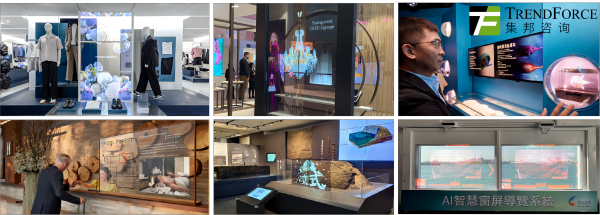
Credit: TrendForce
What is a transparent LED display?
The transparent LED display, as the name suggests, stands out for its transparent display form. In comparison to conventional LED display products, the transparent LED screens commonly found on the market today boast high transparency and ultra-lightweight features. This achievement stems from innovations in the strip manufacturing process and SMD production, LED packaging, and control system improvements. Additionally, the incorporation of hollow structural design reduces obstruction to the user’s view, significantly enhancing the see-through effect of the LED display.
According to TrendForce’s "2024 Global LED Video Wall Market Report," transparent LED displays come in varying specifications compared to conventional video walls. They differ in horizontal and vertical pitch and can be categorized into those for indoor use with brightness ranging from 4,000 to 5,000 cd/m2 and 75% transparency, and those for outdoor use with higher brightness levels. They can also be classified by LED chip arrangement, namely front-lit and edge-lit transparent screens, with front-lit models gradually becoming the mainstream.
Currently, transparent displays can be seen in department stores and have been applied to stage decoration, media advertising, creative tourism, and many other settings, with China being the primary market, followed by Europe, America, and Asia.
The popularity of these applications is due to several characteristics of transparent LED screens. Firstly, their structure is more flexible compared to conventional LED display cabinets, allowing for customization to fit specific glass dimensions better. Secondly, transparent displays offer high see-through effects, noiselessness, and low power consumption. Thirdly, they are easy to maintain, safe, and save manpower and resources. Lastly, their display effect is more appealing than ordinary screens, playing a positive role in attracting foot traffic and disseminating information.
Despite the rich advantages of transparent LED displays, they face challenges such as the trade-off between brightness, clarity, and transparency, as well as difficulties in further improving performance.
To address these challenges, manufacturers have developed various solutions. Transparent LED displays now include categories like crystal film screens, adhesive film screens, and electro-optic glass, which greatly optimize product weight and transparency while ensuring maximum display transmittance compared to conventional transparent screens.
Crystal film display: The crystal film LED display is made of flexible transparent films, characterized by lightness, slimness, and design flexibility. By applying laser etching circuits, the line width can be better controlled to ensure uniform impedance, making the brightness of each LED chip consistent. This leads to uniform brightness of the displayed content, while the transmittance of a crystal film screen can reach up to 95%.

Crystal film LED display Adhesive film LED display
Credit: JinChangHong LED Display
Adhesive film display: With the use of specified dies and unique encapsulation process, the adhesive film LED display fixes its components on high-transparency PCB boards, integrating display modules into high-transmission lens-based substrates. The product thickness is only 1-3mm. The transparency of adhesive displays can reach 70%-95% without affecting indoor and outdoor lighting. Brackets are not needed when installing the display, which can present various contents in curved surfaces without blindside or color deviations. An adhesive film screen is able to save more than 30% of energy use compared to regular models.
Electro-optic glass: The LED electro-optic glass is a comprehensive technical product integrating LED chips, driver ICs, embedded control systems, glass deep processing, and chemical engineering processes. Specifically, LED chips are embedded between two glass sheets, and the technology of glass conductive coating is used to achieve electro-optical display effects. The product has a longer lifespan, better display effects, and features such as high temperature resistance and waterproofing. The glass can be divided into single-color static, single-color dynamic, and full-color dynamic displays.
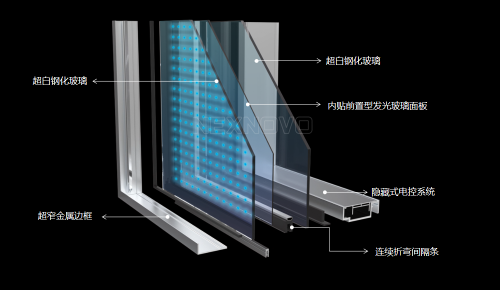
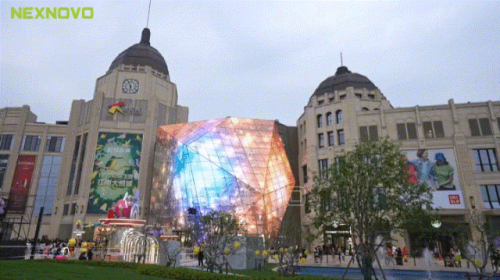
Credit: NEXNOVO
Crystal film screens, adhesive film displays, electro-optic glass, and other emerging transparent LED screens are now mainly targeted at the mid-to-high-end commercial display market. Therefore, the prices of these products are relatively high compared to regular transparent displays. However, transparency, slimness, display quality, and protective performance have also been improved.
Facing applications in large indoor and outdoor spaces such as retail department stores and museums, various types of transparent LED displays tailored for specific use have emerged. These displays present equally stunning visual effects on buildings made of different materials. In the future, with the introduction of Micro LED technology, applications of transparent LED displays will further expand.
Micro LED Will Become a New Technology for Transparent Displays
Transparent Micro LED screens are different from regular transparent products. While conventional transparent displays innovate the application of strip screens, Micro LED displays are powered by smaller chips with higher brightness, lower power consumption, longer lifespan, and faster response, along with glass substrates. With the high transparency of glass substrates and the superior display performance of Micro LEDs, transparent Micro LED displays can achieve both high transparency and high definition effects, promising even more exciting prospects for future development.
Today, major display manufacturers such as AUO, Samsung, Tianma, and PlayNitride have entered the transparent Micro LED market, expanding the application of transparent LED products from public transportation and commercial applications to areas such as automotive displays and consumer electronics.
AUO: Reportedly, AUO’s transparent Micro LED screens are applicable to retail, public transportation, automotive displays, consumer electronics, and other fields. Just recently, Lenovo unveiled a concept laptop called the ThinkBook featuring AUO’s 17.3-inch transparent Micro LED display with a resolution of 720P and a brightness of up to 1,000 nits.

Credit: Lenovo
For the retail and public transportation sectors, AUO launched a 60-inch Micro LED screen last year. In January 2023, AUO collaborated with the Industrial Technology Research Institute (ITRI) and the Ship and Ocean Industries R&D Center in Taiwan to introduce its latest transparent Micro LED display on the smart ferry in Kaohsiung, expanding the development opportunities for transparent LED screens in railroad economies and smart transportation.
For the automotive display field, AUO has released transparent Micro LED displays in various sizes, including a series of 60-inch displays, a 30-inch screen, a high-transparency interactive car window, a 13.5-inch 163PPI device, and a 17.3-inch display.
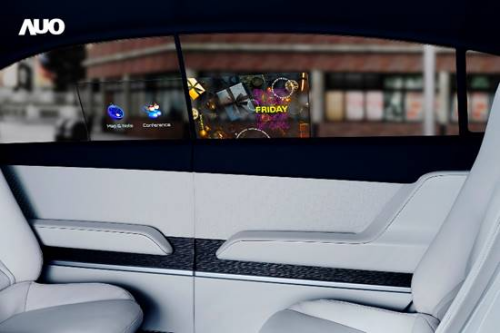
Interactive Micro LED smart car window with high transparency (credit: AUO)
Tianma: Tianma has released multiple transparent Micro LED displays for automotive use, including the industry’s first transparent Micro LED display with a reflectance as low as 4% and a transmittance of over 65%, the world’s first 8.75-inch Micro LED display with over 70% transparency, and the 9.38-inch transparent Micro LED adjustable screen. Tianma has demonstrated the perfect compatibility between Micro LED transparent screens and automobiles.
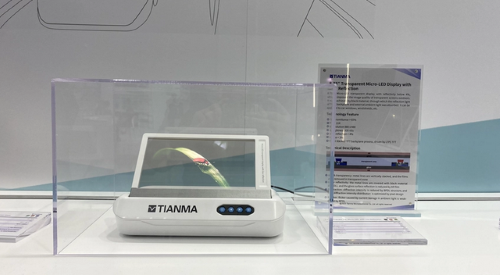
Transparent automotive Micro LED display with a reflectance rate of only 4% (credit: Tianma)
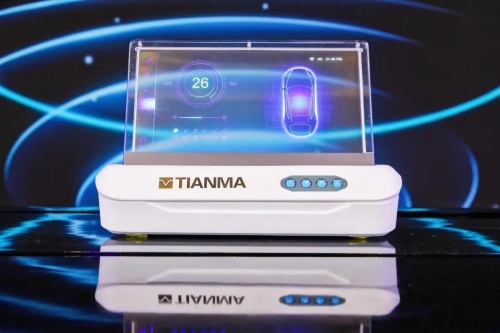
The 9.38-incn transparent Micro LED adjustable screen (credit: Tianma)
PlayNitride: PlayNitride is also driving the development of transparent Micro LED display technology. In August last year, PlayNitride, together with Taiwan’s Industrial Technology Research Institute (ITRI) and Moonshine Studio, jointly announced a highly transparent and high-brightness Micro LED display, which was introduced into the deep-sea fish specimen display area of the Xpark Aquarium in Taoyuan, Taiwan.
As for automotive products, PlayNitride revealed last year that the company’s transparent Micro LED displays (samples) have been shipped in small batches, and it is expected that the automotive display business will take about two to three years to grow.
Samsung: Samsung has brought Micro LED technology from large-size commercial displays and the television sector into the realm of transparent screens. At CES 2024 earlier this year, the display maker unveiled the world’s first transparent Micro LED display featuring three transparency levels. Two of them involve the use of colored glass, while the other made of transparent glass, all featuring a borderless design.
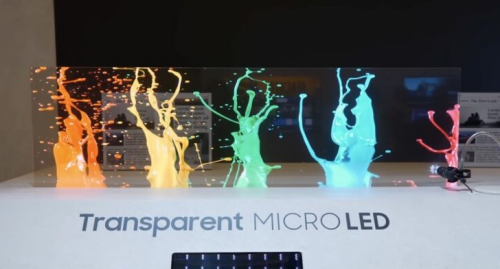
Samsung’s transparent Micro LED display
Conclusion
Today, transparent LED screens are being used in various commercial and public spaces, blending virtual and visual elements to enhance the charm of buildings and offer innovative platforms for information dissemination and arts promotion.
In the future, with the application of Micro LED technology, transparent LED screens will experience a resurgence, especially in the realm of car displays. Though the display technology is still developing, manufacturers are actively pushing for the integration of transparent Micro LED screens into vehicles.
According to TrendForce’s 2024 Global LED Display Market Report, the market size of transparent LED screens is expected to reach $141 million in 2023, with a year-on-year growth of 4%. With the driving demand from markets like retail and creative tourism, coupled with the emergence of Micro LED transparent display technology, the market size of transparent LED displays is expected to reach $238 million by 2027, with a compound annual growth rate of 12% from 2022 to 2027.
Additionally, TrendForce suggests that in the future, transparent Micro LED displays will be used for external advertising and internal information display in smart cars. It is anticipated that transparent Micro LED screens will be introduced to the automotive market in 2026-2027, with European, American, and Japanese automakers leading the way in using them for augmented reality heads-up displays (AR-HUDs) or car window displays. (By Irving from LEDinside)
TrendForce 2024 Global LED Video Wall Market Outlook and Price Cost Analysis
Release Date: 28 September 2023
Language: Traditional Chinese / English
Format: PDF
Page: 273
|
If you would like to know more details , please contact:
|





 CN
TW
EN
CN
TW
EN












